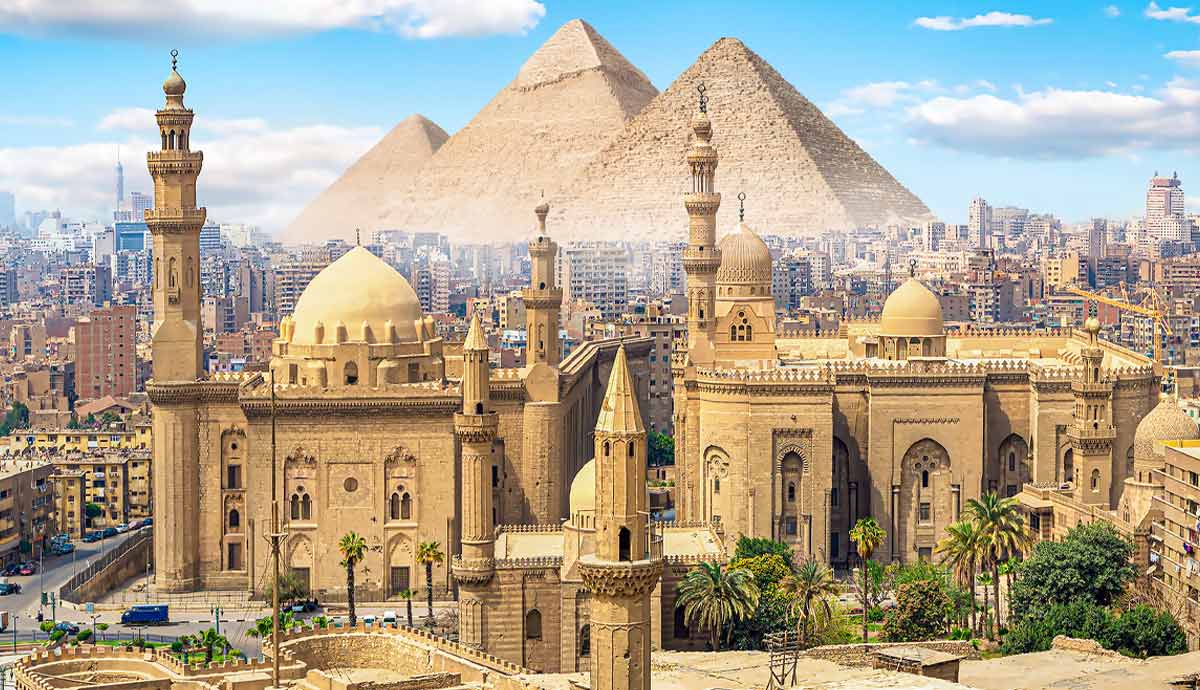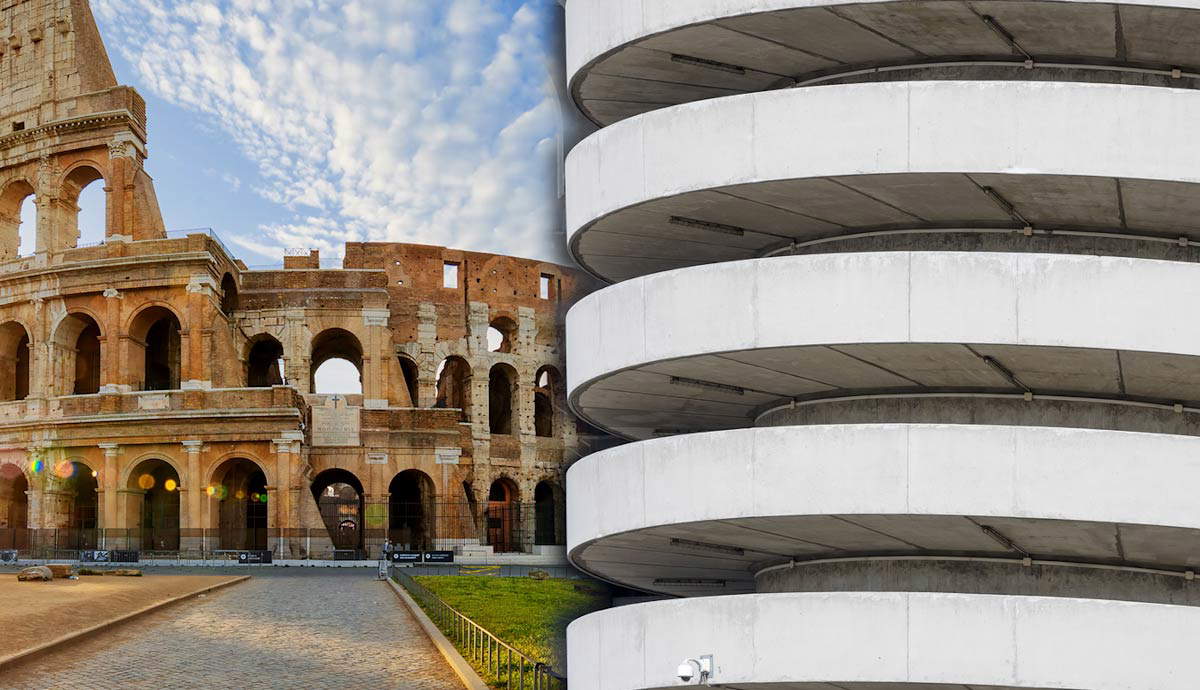
Despite the proximity of the Pyramids at Giza, Cairo is not an ancient Pharaonic city. In fact, as UC Berkeley architect and historian Nezar AlSaayad notes, the city’s origins are medieval except for a small area of greater Cairo. Today’s sprawling city grew out of a series of settlements following the arrival of Arab conquerors and the Islamic faith in 640 CE. Cairo’s urban landscape has rapidly evolved in the last century. For example, journalist Jack Shenker points out that only two percent of the population lives in areas of Cairo that were inhabited at the time of Napoleon’s invasion in 1798!
1. Coptic/Old Cairo

Before the Arab conquest of Egypt in 640 CE, Roman fortifications existed in some parts of modern Cairo. Moreover, there was an ancient Egyptian religious complex and port at On. Nezar AlSaayad says the Romans built a fortress at On and called it Babylon.
Today, the city’s Roman ruins lie in the Coptic or Old Cairo area. The Copts make up most of Egypt’s Christian population. Christianity came to Egypt in the first century. Indeed, Egypt became one of the earliest centers of the Christian faith in the Roman Empire.
However, at that time, Alexandria was Egypt’s capital city. Indeed, it would be centuries (and several conquerors later) before Cairo eclipsed Alexandria’s status in Egypt.
An Arab army under Amr Ibn Al-As conquered Egypt and introduced the Islamic faith in 640 CE. The following year, his army seized Alexandria, Egypt’s capital, from the Byzantine Empire.
Egypt’s new rulers founded a settlement known as Al Fustat (Arabic for “the tents”) in 641. Fustat would become one of the foundations for the modern city of Cairo.
2. Mosque of Ibn Tulun

Built by its namesake, Ahmad Ibn Tulun, between 876 and 879 CE, this grand mosque is Cairo’s oldest functioning Islamic monument. It is also the last remnant of Al Katai, founded by Ibn Tulun of Egypt’s Tulunid dynasty (868-905). Al Katai had eclipsed both Fustat and the Abbasid city of Al Askar as the main settlement of what would become Cairo.
Ahmad Ibn Tulun was the son of an enslaved member of the Abbasid caliph’s service in their capital of Samarra in Iraq. He excelled in his studies and was selected by the Abbasid caliph to govern Egypt.
By the tenth century, the Fatimids replaced the Abbasids and Tulunids as Egypt’s rulers. The Fatimids founded Al-Qahira (The City Victorious), the origin of the word “Cairo” in 969. For centuries, Al-Qahira remained a separate settlement from Fustat. Al-Askar had been abandoned, and Nezar AlSaayad says no archaeological trace remains.
Al-Qahira, or Cairo, remained separate from Fustat and was reserved exclusively for the Fatimid ruling elite. While later dynasties connected both cities, there are reminders of Fatimid Al-Qahira’s private palace-city origins to this day. For example, several monuments appear on this list, including the al-Azhar Mosque and the Fatimid-era city gates.
3. Al Azhar Mosque

Al Azhar is one of Cairo’s oldest surviving mosques, founded in 970 CE by the Fatimids. Indeed, the mosque was meant to be one of the centerpieces of the new Fatimid palace city of Cairo. It also hosts one of the oldest surviving universities.
Al Azhar’s story is also a good place to discuss Egypt’s shifting religious makeup. Unlike early Arab dynasties, the Fatimids were followers of Shi’a Islam. However, Egypt’s majority religion became Sunni Islam during the reign of Saladin in the twelfth century.
Writer Tim Mackintosh-Smith notes that Napoleon sought to impress the leadership of Al Azhar when the French arrived in 1798. However, when a popular uprising broke out in 1798 over French tax plans, Napoleon ordered troops to desecrate Al Azhar.
4. The Citadel

The fortress called the Citadel has commanded Cairo’s defenses since its twelfth-century construction. Saladin, a legendary Muslim commander and founder of the Kurdish Ayyubid dynasty, ordered the Citadel’s construction during the Crusades.
After Saladin, many of Egypt’s rulers held court in the Citadel for the next seven centuries.
However, Shagarat al-Durr is the most unique ruler to live at the Citadel. For instance, Nezar AlSaayad points out that Shagarat al-Durr—whose name literally means “the tree of pearls”—was the only Muslim woman to rule Egypt.
Due to a succession crisis, Shagarat al-Durr became Egypt’s sultana for roughly two months in 1250. This crisis led to the rise of the Mamluks and Shagarat al-Durr’s murder.
As AlSayyad explains, the Mamluks were a clan of enslaved military personnel initially brought to Egypt from areas like the Caucasus to serve the Ayyubid dynasty. In fact, the term “Mamluk,” AlSaayad notes, means “those who are owned.”
The Mamluks had become so indispensable that no Egyptian ruler could govern without their consent. By 1260, Mamluk general al-Zahir Baybars founded what became known as the Bahri Mamluk dynasty.

The Citadel also became important in the story of Egypt’s last ruling dynasty, established by Muhammad Ali Pasha in the nineteenth century. Muhammad Ali Pasha and his successors were technically autonomous vassals of the Ottoman Empire until 1919. However, this did not stop Muhammad Ali from building grand monuments to showcase his personal authority.
Indeed, the Citadel is the site of a grand mosque built by Muhammad Ali Pasha. Also known as the Alabaster Mosque, it was built in the final years of his reign between 1830 and 1848. It houses his tomb.
Moreover, one could say the Citadel is where Muhammad Ali Pasha’s dynasty began. For example, in 1811, Muhammad Ali Pasha had the last of Egypt’s Mamluk leaders assassinated within one of the Citadel’s gates.
5. Mosque-Madrasa of Sultan Hasan

Indeed, conspiracies and murders are common events in Egypt’s political history. The fate of the last Mamluk leaders in the nineteenth century is like the story of Egypt’s fourteenth-century sultan, Hasan. For example, after a brief reign, conspiring generals murdered Sultan Hasan. But not before Sultan Hasan began building one of the city’s most impressive architectural landmarks: the Mosque-Madrasa of Sultan Hasan.
The young Sultan Hasan began constructing the mosque in 1356 near the Citadel. According to Nezar AlSaayad, work continued for five years until financial and political issues halted construction. For instance, Sultan Hasan had been deposed and reinstated no less than three times because of political disputes between rival Mamluk leaders.
The Ar-Rifai Mosque stands opposite the Mosque-Madrasa of Sultan Hasan. It was built between 1869 and 1912 and houses the tombs of many Egyptian royals and the last shah of Iran.
6. Cairo’s City Gates

Like virtually any ancient or medieval city, Cairo’s rulers built impressive city walls. Three city gates are of note and can be seen today. First, there is Bab al-Futuh (Gate of Conquest). Next, there is Bab al-Nasr (Gate of Victory). Finally, the massive twin-minareted gate of Bab Zuweila stands at the entrance to Cairo’s medieval core.
Bab Zuweila underwent a series of renovations under Egypt’s succession of rulers. It was initially built in the twelfth century. However, the minarets were added in the fourteenth century because of the construction of a mosque within the walls.
Moreover, Bab Zuweila became the site of the symbolic fall of the Mamluk caliphate and the rise of Ottoman rule in Egypt. Historian of Middle Eastern History Eugene Rogan explains that the final Mamluk ruler, Tumanbey, was hanged at Bab Zuweila by the victorious Ottomans in 1517.
7. Khan Al Khalili

Today’s souvenir stalls and shops do not convey the significance of the winding medieval alleyways of the open-air market known as Khan Al Khalili. In fact, this market is a remnant of Cairo’s past as a significant global commercial center. Specifically, this marketplace dates to the heyday of Mamluk sultans.
Although prolific warriors, the Mamluks’ source of wealth was not military conquest but trade. Indeed, as Tim Mackintosh-Smith points out, the Mamluks partnered with the Venetians to control the east-west trade across the Mediterranean. Thus, Europe’s access to luxury goods and spices from India and East Asia came through Mamluk-controlled trade routes.
However, Vasco da Gama’s discovery of a sea route around the Cape of Good Hope and growing Ottoman power diminished Mamluk power.
8. The Egyptian Museum

The iconic, pink-powdered palace that is the Egyptian Museum first opened in 1902. The museum built upon earlier traditions of preserving Egypt’s antiquities. For example, Muhammad Ali Pasha banned the export of antiquities from Egypt in the 1830s.
Sadly, few archaeologists listened to the Egyptian ruler’s prohibition. Indeed, French archaeologist Auguste Mariette was in the process of exporting archaeological finds to the Louvre when he was tasked with organizing the Egyptian Antiquities Service in 1858.
Mariette’s collection of Egyptian antiquities became the basis for the collection displayed at the Egyptian Museum in 1902. It continued until Egyptian authorities began transporting exhibits to the Grand Egyptian Museum (GEM) in Giza. This museum is slated to fully open in late 2024.
However, even after the GEM is fully operational, the Egyptian Museum will remain one of the world’s most important collections of Egyptian antiquities.
The Egyptian Museum is one of the city’s monuments dating from the days of the so-called “Veiled Protectorate.” Although still nominally part of the Ottoman Empire, Britain was the real power in Egypt by the final decades of the nineteenth century. Hence, “veiled” was used to describe British power in Egypt.
Indeed, British officials remained in positions of power even after Egypt achieved a semblance of independence in 1919. British influence remained strong upon the foundation of the Kingdom of Egypt in 1922.
9. Baron Empain Palace, Heliopolis

Why did a Belgian aristocrat build a palace in Cairo? Édouard Louis Joseph, 1st Baron Empain was a prominent Belgian industrialist, financier, general, and amateur Egyptologist.
Baron Empain designed the neighborhood of Heliopolis as a “garden city” for Cairo’s colonial bureaucrats and elites. The palace features eclectic architectural influences, including features inspired by famous landmarks like the Temple of Angkor Wat in Cambodia. It was completed in 1911.
After closing in the late 1990s, the palace was reopened to the public in 2020, following extensive renovations.
10. Cairo Tower

Cairo Tower is a testament to its visionary, Egyptian President Gamal Abdel Nasser (President of Egypt 1954-1970). An Egyptian nationalist since his youth, Nasser became a crucial player in the military revolution that deposed Egypt’s monarchy in 1952. In 1956, Nasser took the bold step of nationalizing the Suez Canal and faced down foreign challengers in the subsequent Suez Crisis.
A similar bold spirit motivated Nasser’s construction of the Cairo Tower in 1961. For instance, Nasser used American funds earmarked for weapons to build the tower instead. Journalist and travel writer Anthony Sattin explains that this demonstrated Nasser’s political strategy during the Cold War as an architect of the Non-Aligned Movement.
11. Ramses II Obelisk, Tahrir Square

In 2020, officials inaugurated the installation of the Ramses II Obelisk in central Tahrir Square. The obelisk, which dates from the reign of Ramses II or The Great, was moved from the San Al Hagar archaeological site. While Cairo may not be a Pharaonic city, its main nineteenth-century square now has a monument to bring this history to the heart of Cairo.
Journalist Peter Hessler described Tahrir Square as less of a square than “a traffic circle with an endless stream of cars revolving around its center.” Nevertheless, Tahrir Square is a significant part of the history of Cairo and modern Egypt.
Originally named Ismailia Square after its founder, Khedive Ismail, Tahrir Square is the heart of central Cairo.
Professor and political scientist Malath Al-Agha explains that Tahrir Square is perhaps best known for its role in the country’s revolutionary movements between 2011 and 2013. Many observers have suggested this is a fitting connection, as Tahrir means “liberation” in Arabic.
The lack of an extensive ancient past does not diminish Cairo’s importance to Egypt’s history. In fact, many Cairenes call their city Umm Ad Dunya (the Mother of the World). The history behind these eleven monuments makes a strong case for the city’s nickname.










